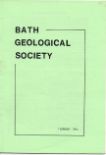Aspects of South Australian Geology

A lecture was given on “Aspects of South Australian Geology” by Dr B P J Williams of Bristol University to the Society on 10th November 1983. This was breaking new ground for us and the excellent slides and running commentary provided an appetizer for a field trip being planned for 1986.
I must apologise in advance for the somewhat sketchy remarks set out below. The lecture was given with the lights out and my notes were like an eighteenth century letter with crossed writing to save the postage due.
The greater part of Australia is Precambrian but the eastern seaboard is of later origin. He referred to the GAWLER CRATON and to the YUGARN BLOCK to the west of it, also the very great depths of sedimentation which had been laid down, some to a depth of 15,000 ft. The Cooper Basin is Permo-triassic and is now being explored for gas and oil. The Murray Basin is thought to be very old, perhaps Upper Archaean.
The ADELAIDE GEOSYNCLINE is very marked and can be traced for many miles in a north-easterly direction. The FLINDERS RANGE is six to seven hundred million years old and contains the POUND QUARTZITE which is found the oldest known soft-bodied fossils. The MOUNT LOFTY RANGES are of late proterozoic rocks.
There have been at least two glacial sequences, one at 1100my and one at 790my ago. Hence the glacial deposits and TILLITE which are found. These are said to be the earliest deposits of this kind in the world. Mention was made of STURT GORGE where lake conditions had produced VARVITES or RHYTHMITES.
TATLEY HILL was shown to be an area where a gas pipe-line was being laid. Here the calcareous rocks had been dolomitized and showed ripple marks, siltys and pressure lines. The OOLITES were 1000my old with stromatolites and showed TEEPEE structures and polygon features on the surface.
Dr Williams then referred us to the coastal region where at Halletts Cove there was evidence of shelf sediments and fan deposits with Turbidities. He indicated with slides the storm-affected shelf.
THE FLINDERS RANGE is a periclinal fold with ORDOVICIAN DIAPIRS. The Diapirs are 900 to 1000my old and are thought to have been brought to the surface by the extremely heavy depth of sediment providing the pressure. These Diapirs show considerable mineralisation.
Inland we were shown a slide of a settlement miles from any other habitation. This was HAWKER run by a man called Teague who is an expert on the area. Here there is mudstone and quartzite and the POUND area now covered with scrub and is thought to have been rich pasture land in the not too distant past and before that an impounded area. The thickness of the quartzite hereabouts is estimated at 300 metres.
TORREN RANGE has a thickness of 10,500 ft of sediment in the area of Blinmon and stromatolites can be seen here.
Back we came with the lecture to the coast and to Kangaroo Island. The rocks on the north side are cambrian. The Island is 30 miles long and has mudstones and sandstones with TILLITE shales, black microlite, fluvial conglomerates and submarine delta. There are aeolian deposits on cambrian rocks with calcrete on top.
On the coast there are Plutons showing, having been pushed up and partially exposed, the erosion having acted on the sedimentary rocks but not the more resistant granite.
To the west and northwest of the area is a basin which has yet to be explored. This was an alkaline playa basin and contains TRONA STROMTITE, EPSOMITE and CHERT. Here is an untapped basin likely to supply plenty of hydro-carbons in the way of oil and gas.
The lecture ended with an exhortation to go away and save for the FIELD TRIP OF YOUR LIFE.
